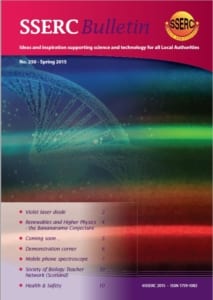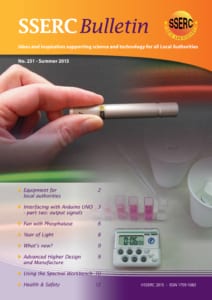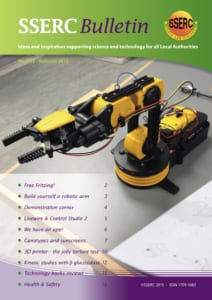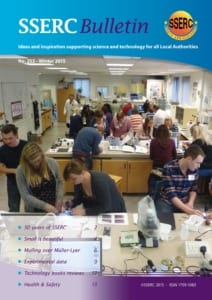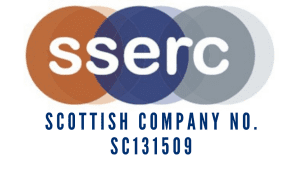Violet laser diode
In Bulletin 229 we rejoiced that at last an inexpensive Class 2 green laser diode module (LDM) was available. Now we have at last been able to buy a violet laser diode module (405 nm). As with the green unit, our violet LDM has automatic power control and comes from the same reputable company, Roithner Lasertechnik in Vienna.
Renewables and Higher Physics – the Bananarama Conjecture
A look at the new Researching Physics Unit exemplar on renewables
Demonstration corner – Flame Colours’
A striking demonstration of a range of colours imparted to flames by metal ions. The striking part being that they are all on display simultaneously.
Mobile phone spectroscope
Spectroscopy is an important technique in many areas of science, not least Advanced Higher Chemistry. In this, part one of a two-part article, we show you how to make a simple, cheap type of spectrometer that can be fixed to your mobile phone to enable you to photograph the spectra.
Health & Safety
Working with DNA
Changes to the legislation that controls the way work with DNA is regulated, and the increasing availability of DNA practical work for schools makes a review of the guidance for experimental work with DNA in schools appropriate at this time.
Whole School Risk Assessments
Whole school risk assessments for nursery, primary and secondary schools.
Equipment for Local Authorities
Once again, SSERC has been able to source 3 substantial pieces of scientific equipment to give out to local authorities on a permanent loan, from where you will be able to borrow them for your schools
Interfacing with the Arduino Uno (part 2)
Following on from the article in Bulletin 249 (interfacing with the Arduino Uno platform), here is the promised follow-up article on interfacing.
Fun with Phosphatase
A straightforward procedure using the phosphatase to investigate enzyme kinetics in general and product inhibition in particular.
What’s New?
News of what is happening here at SSERC
Using Spectral Workbench
In a follow up to last issue’s article on how to construct a simple smartphone spectroscope, this article shows a straightforward way to analyse those pictures to get usable spectra.
Health & Safety
RPA and Risk Assessments
A new Radiation Protection Advisor for Scotland and some updated Risk Assessments for Design and Technology.
Free Fritzing! – An introduction to some free software which allows electronics circuits to be graphically drawn and documented, then used throughout Engineering Science courses in your department.
Build yourself a robotic arm – A guide to a self-assembly Robotic Arm with USB Interface allows your pupils to progress through a reasonably well instructed assembly process, allowing individuals or teams of pupils to achieve the satisfaction of completing the project with whatever levels of teacher input deemed necessary.
Demonstration Corner – How to carry out the spectacular chip-pan fire demonstration safely in the classroom.
Livewire & Control Studio 2 – Free electrical circuit simulation software for your Technical Education department from SSERC.
We have an app! – Using funding from SQA, SSERC has been working with a software developer to create a simple app to help students understand average speed. SSERC Speed Camera works like a real speed camera. It captures two successive images of a moving object. If we know the time between each image and the distance travelled in that time, the average speed can be found.
Cyanotypes and sunscreens – How to use the old iron-based cyanotype photographic process as a way to determine uv exposure and investigate sunscreens.
Give your 3D printer the jolly torture test – How to use your new 3D printer to make a fantastic little scale model boat, designed by Creative-Tools.com to be quickly produced and economical with the amount of material used.
Kinetic studies with beta-glucosidase – In this article we explore the merits of β-glucosidase for enzyme kinetics studies. The enzyme is found in both prokaryotic and eukaryotic systems and has been shown to play important roles in a variety of biochemical processes.
Technology Books – Reviews of: Getting Started with Processing by Casey Reas & Ben Fry and Getting Started with Arduino (3rd Edition), by Massimo Banzi & Michael Shiloh.
Health & Safety update – Thermit, Rubber tubing, the hazards of YouTube and Torula food yeast.
50 Years of SSERC – The development of SSERC ove the first 50 years. And an appreciation of the late Allen Cochrane, erstwhile chemist at SSERC.
Small is beautiful – An article that gives an introduction to various microscale techniques that can be used in the chemistry laboratory and a showcase of some of the resources available in the microscale section of the Chemistry area of the website.
Mulling over Muller-Lyer – An approach to using the Muller-Lyer illusion as the basis for an investigation into perception for Higher Human Biology
Experimental Data – Showcasing the presence and possible uses of some data sets now available on the SSERC website through the resources section for Higher Biology or Higher Human Biology.
Technology Books – Reviews of: Getting Started with Processing by Casey Reas & Ben Fry and Getting Started with Arduino (3rd Edition), by Massimo Banzi & Michael Shiloh.
Countdown to Physics Safety – A look at what we believe are the top three issues in school
physics health and safety: High Tension Power Supplies, Laser Pointers and Radioluminescent Dials.
There is also an update on Face masks
Ionising Radiation Web Page – An introduction and guide to the recently revamped Ionising Radiation section of the Physics Health & Safety area of the website.

